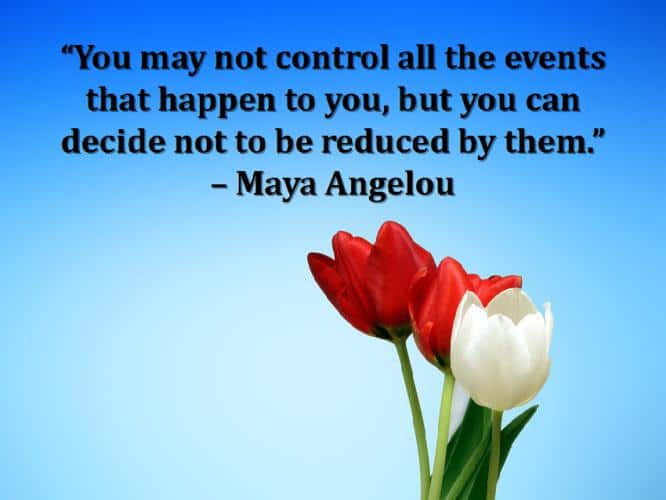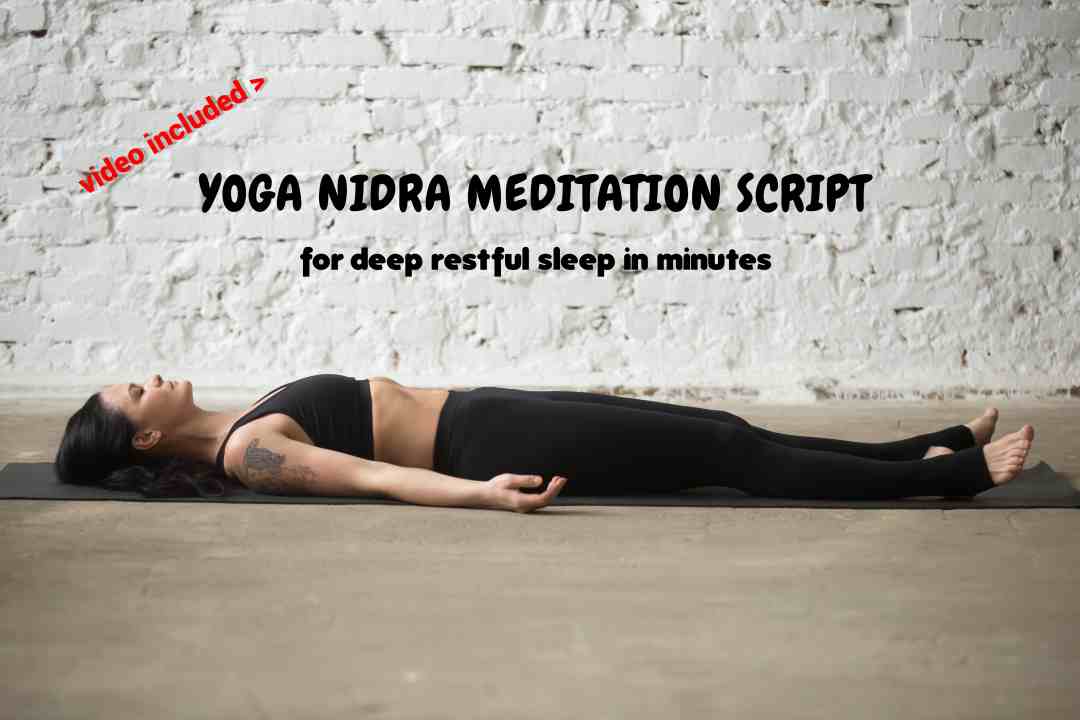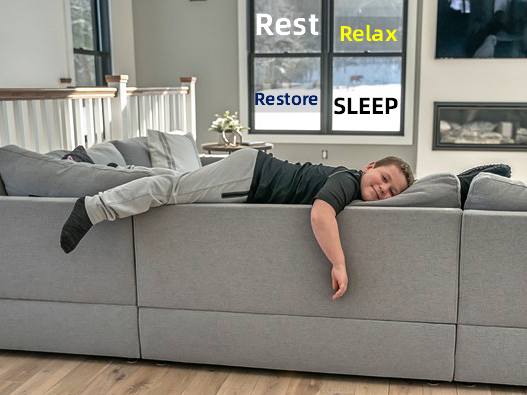Anxiety is your body’s natural response to stress. It’s a feeling of fear about what’s going to happen next. Being a victim of anxiety myself, the feeling or sensations of panic and fear are truly overwhelming. Our minds are under so much stress and fear that it projects made-up situations that make us believe it is true.
In my teen years, the stress of doing well academically, gave me anxiety attacks every night. It felt like I had to prove myself to be the best even if I did not like studying. From here, my anxiety disorder journey began at every phase of my life, even if it was for small things like getting late for a movie. I was panicking for things that were not in my control. This brought pain, health-ailments, sleep disorder, weight gain and loss of confidence in myself. Fighting anxiety was taking a toll on my life and affecting my social relationships as well. I would tell myself every night, “I don’t want to live if I have to feel like this every day.”
However, my life changed when I met some people who made anxiety look like it was no big deal. They made me understand why did I feel anxious all the time and what were the triggers behind it. The triggers for anxiety for many, goes way back to your past, your fears, and your mindset. This is when my journey to self-healing began, to learn anxiety management techniques that made me feel calmer and peaceful.
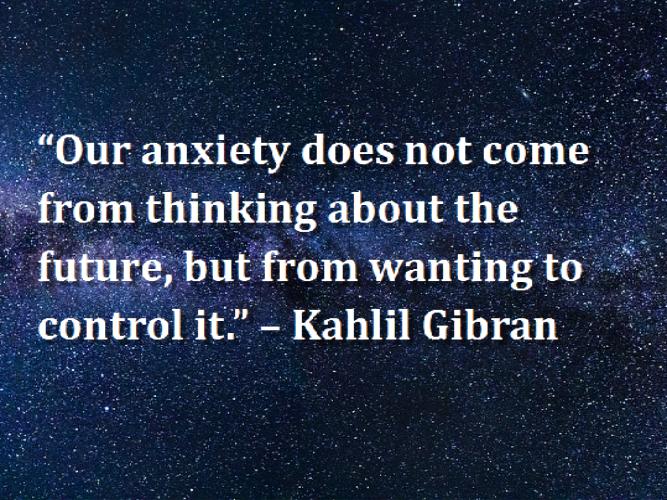
“Our anxiety does not come from thinking about the future, but from wanting to control it.” – Kahlil Gibran
Thus, I would like to share the 10 best anxiety management techniques that have made a big difference in my on-going journey.
10 Best Anxiety Management Techniques
Therapy and medications are ways to control and heal anxiety but this does not last. You are made dependent on medicines to feel better every time you have an anxiety attack. However, anxiety-management techniques can offer relief, and very effectively. In the United States alone, around 40 million adults are diagnosed with anxiety disorders and depression brought on by stress and worry.
These anxiety management techniques fall under 3 clusters that will help you to understand your triggers easily and intend to cure you of anxiety.
- Physical Arousal
- Stress and Tension
- Mental Anguish
Cluster One: Anxiety Management techniques
Physical arousal
Anxiety takes over our body that constitutes the feeling of stress and worry. It causes intolerable symptoms such as heart-thumping rapidly, short of breath, pulse-racing, and dizziness. These can occur unexpectedly and be quite distressing. Experiencing high levels of anxiety can cause pain in your neck, jaw, and back.
Are you familiar with the feeling when the elevator drops down and you experience a sinking feeling in your stomach? Well, that is what a person from anxiety feels most the time. Thus, following anxiety management techniques concentrating on your body needs will help you control your anxiety attacks. They can be reduced by regular self-care and relaxation.
1. Nurture your Body
Feeling bouts of anxiety the next morning after a late-night party or dinner is a very common trigger that we often misunderstand for tiredness or hangover. We do not realize that our intake of unhealthy junk food, alcohol, nicotine, caffeine, and sugar raise anxiety levels in our body. A simple rule that should remain our first priority in anxiety management techniques is to manage and nurture our body.
- Eat healthy and nutritious meals to calm your anxiety triggers. Eating regularly can normalize your blood sugar levels and make a difference in your mood and energy levels as well.
- Avoid or reduce your alcohol, nicotine, sugar and caffeine intake.
- Include physical activities or exercise in your daily routine. Exercise can be helpful to your mental well-being. A walk in the park or practicing yoga has proved to calm anxiety down.
- Sleeping on time and sleeping enough can give you the energy to cope with difficult situations, experiences, and feelings. A good 7-8 hours of sleep can reverse the effects of anxiety and many other health disorders. If you find it difficult to sleep, put some lavender essential oil on your pillow or drink a glass of turmeric milk to help you sleep easily.
- Women who have gone through pregnancy, postpartum changes, hysterectomy, menopause and interrupted menstrual cycles experience symptoms of anxiety. Imbalance of the thyroid function also causes anxiety in women. Thus, it is important to look into hormonal changes and stabilize them immediately.

2. Breathing the Right Way
Breathing the right way, will slow down or stop the anxiety response. It will provide a sense of relaxation and calmness. For those who practice yoga, will understand how breathing has a positive effect on their boy, mind, and soul. It fills your body with oxygen sending blood to the brain that gives signals to the nerves to calm down. Practicing breathing exercises like Anuloma Viloma or simple Pranayama can ward off your anxiety issues. However, start with breathing for a shorter period to alleviate anxiety.
- Practice conscious deep breathing for 1 minute at a time, 10 to 15 times a day especially when you are waiting for something. For example, waiting in a queue, stopped at a traffic light, before an exam to begin or an interview to start.
- Try extending your breath as you exhale out. If you breathe in for 4 seconds then breathe out for 5 to 6 seconds. Practice this cycle a few minutes each day, or whenever you start to feel anxious.
- Try these Yoga techniques to Breathe at home easily without any tutor.

3. Mindful Awareness
Many a time we feel that we have cured ourselves from having another anxiety attack but at the back of our mind it still lingers that “what if I get another anxiety attack?” We continue to contemplate and procrastinate on how anxiety will bestow upon us. We let anxiety control our body and mind. Thus, being mindful is one of the important anxiety management technique to follow.
By changing our focus, we can easily diminish the thought of having another anxiety or panic attack. This simple anxiety management technique, “mindful awareness” exercise has 3 simple steps, which are repeated several times.
- Close your eyes and take a deep breath in. As you breathe in, observe your breathing, notice your body, how the intake of air feels, and what sensations you can feel.
- Purposefully shift your awareness away from your body to everything you can hear, smell or feel around you.
- Shift awareness back and forth from your body to what’s going on around you and your surroundings.
Being aware of our body and surroundings in a non-judgemental way can reduce feelings of anxiety and bring a state of calm. You will understand and learn that you have the authority and power to control the many aspects of the world around you. You are able to stop the catastrophic sensations that bring you only stress, worry, panic, and anxiety. It allows you to be more mindful of the present and not let the thought or worry of your future take over.
“You may not control all the events that happen to you, but you can decide not to be reduced by them.” – Maya Angelou
Cluster two: Anxiety Management techniques
Stress and Tension
Those who suffer from anxiety disorder are always in the search for the reasons behind their anxiety. They hope they can “solve” whatever problem seems to be causing anxiety and thus relieve their symptoms.
Anxiety is accompanied by mental activity that is distracting and unproductive. This includes worry, fears and imagined negative outcomes. The more you worry, the more it is likely to occur. But, since their stress and tension is at a much-heightened level, they simply waste time assuming their symptoms instead of working it out in a more natural way. The following methods are most helpful for diminishing chronic tension.
4. Ignore the Voice of Worry
This sinking feeling inside comes from low-grade fear that causes physical disabilities such as headaches, joint pain, and ulcers. When you are anxious you tend to think of the worst possible outcome of any situation which is unlikely to happen. For example, you are on your way to the airport way before your flight time and you find yourself stuck in traffic, you panic and think of how you will miss your flight and how you will have to buy another ticket or something bad will happen on the way to the airport. Thus, you are worrying for no reason and make it a habit for yourself.
Your brain creates another dimension in your mind to think of situations that are possibly never going to occur. “An idle mind is a devil’s mind” is a perfect quote describing those with an anxiety disorder. Thus, do not listen to the voice inside your head that tells you to worry.
Every time you begin to panic or feel anxious, tell this to yourself, “It’s just my anxious brain firing wrong” or “I am sending positive energy to my mind and my thoughts. This is just a mind’s play.”
Employ logic and challenge your mind to think of an outcome that is more positive and less negative. An outcome that is possible or likely to happen in the near future. This method will decrease the tension by ignoring the voice of worry and bring you into a state of relaxation.

5. Interrupt Anxious Thinking
When anxiety is at its peak, it is very hard to think logically and practically. Your mind loses its control and thinks of everything in a negative light. When you disrupt your anxious thoughts temporarily, you are able to think on a straight rope. There are a number of ways you can do to distract yourself from any anxious thoughts.
Identify if worrying aimlessly and endlessly is a problem for you, then should you rectify it. Try some different and maybe silly ways to interrupt negative thoughts such as:
- Sing your worries to a silly tune, or speak about them in a funny voice. Make them sound ridiculous.
- Pick a happy thought to think about such as something you are very proud of or something you are looking forward to. For example, like meeting your school friend after a long time or completing a project, you have been holding back to do.
- Listen to your favorite music or watch your favorite TV series.
- Intentionally revert your attention back to the task you are performing, and remind yourself that worrying is of no use.

6. Relax and Have Fun
Being anxious all the time fills your body with tensed up muscles, clenched jaws, and a tried mind. This is a cue for you to let loose and enjoy the moment. When you feel you can let go off worry or stress, use these cues to practice relaxation and have fun enabling anxiety management.
For someone who is always anxious and worries, having fun can be a task in itself. However, think of the fun times in your past and try to recuperate it in the present. Laughing is a great exercise to increase feelings of joy and is able to discharge tension in your body. Try some of the ways to loosen and lighten up a bit.
- Try releasing and relaxing your muscles, that is tightened up because of all the built-up tension and stress, with relaxing exercises
- Change your anxious feelings through breathing. When you breathe out, imagine all the stress and fears leaving your system and when you breathe in, replace that energy with peace and positive energy.
- Think of an image or scene that is relaxing to you, and picture this when feeling tense or under stress. For example, a beach destination, or your favorite dish or your favorite person.
- Schedule regular relaxing and enjoyable activities such as massage, warm baths, exercise, or being among nature. Practicing Yoga daily can take a huge load of stress and anxiety of your body and mind.
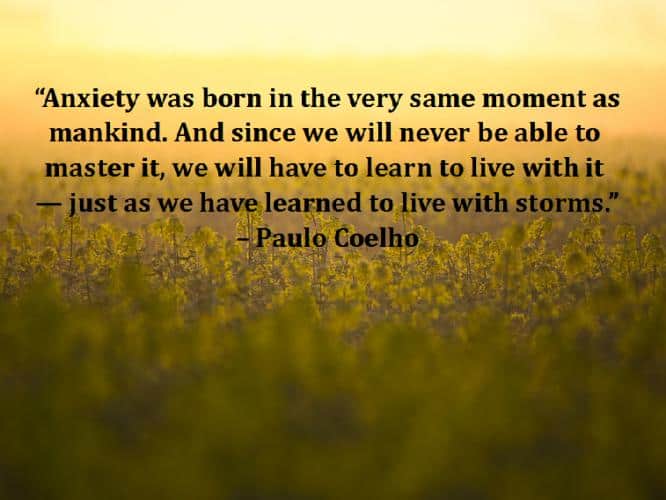
“Anxiety was born in the very same moment as mankind. And since we will never be able to master it, we will have to learn to live with it—just as we have learned to live with storms.” – Paulo Coelho
Cluster three: Anxiety Management techniques
Mental anguish
When your mind does not know how to shut down from thinking back to back anxious thoughts, it leads to suffocating your mental and emotional being. These kinds of thoughts are always lingering in the background and evoke feelings of tension and depression. You lose all concentration and ignore the good things in life.
However, to overcome anxiety, you need to bring changes not to your thoughts alone but in the way, you handle anxiety and stress. Using anxiety management techniques is a way to diminish anxiety.
7. Put a Lid on your Worries – Anxiety Management Techniques
If anxiety and worry have taken over your daily life distracting you from performing your daily tasks then use anxiety management techniques that limit your worry.
- Firstly, identify what is worrying you and if it is solvable or not within your control.
- Secondly, use problem-solving tactics to focus on your worries that are within your control.
- Soon after, brainstorm solutions for your problem, use pros and con lists to decide on the best solution and then, make an action plan to resolve it.
- For unsolvable worries, use relaxation and other techniques to reduce your negative reaction to the situation. Do not panic and increase your blood pressure.
Worry well and only once – For this, keep a worry journal or diary to list your worries once a day for up to 20mins. If that worry reoccurs during the day, remind yourself that “I have already worried about it for today. I will not stress over it.”
Worry box – Imagine an empty container to store your worries. Then, picture yourself emptying your worries into the container, naming them as you go. Soon after, mentally put a lid on it. Invite a peaceful thought or send positive energy to that box. And then, go back to focusing on the task you are working on.
8 Ways to Attract Good Energy in your Life Everyday

8. Coach yourself to Handle Anxiety
Avoiding anxieties in your everyday life is only allowing your fear to grow even more. You are the sole fighter to your anxieties and should approach them with confidence and without fear. Coach yourself using anxiety management techniques to face anxiety-provoking situations. These become easier to follow with time and practice.
- Identify the situations or places that you normally avoid to confront due to anxiety but wish to face them now.
- Rate your fear on a scale of 1 to 10 with 1 being low levels of anxiety and 10 being the highest possible anxiety. The goal of this exercise is to decrease the fear within you. Most of the anxiety stems from fear of failing, losing someone you care about, or of being doomed.
- Indulge in self-talk and ask yourself what is so fearful about the situation that is increasing anxiety in you.
- Most importantly, list all your goals. Then, check on how fear is interfering with them and how would you go about achieving your goals if there was no anxiety.
- Practice to tolerate anxiety in small doses without escaping or facing it. Start with something simple such as waiting in line at a grocery store to make your payment or reaching late for a movie. If you are suffering from high levels of anxiety, it is best to ask for help from your loved ones.
- Avoid negative self-talk as this will increase anxiety and stress in your mind. For example, use affirmations such as “I may feel anxious but I can do this.” Think of other occasions when you have been able to cope with fear. Write them down to remind yourself that you are a fighter.

9. Reduce Over Activity
Do you feel the need to be constantly busy all the time? or Do you find it hard to slow down when you have unplanned free time? Many of you tend to do more, when anxious and stress. Even though high activity can reduce anxiety but not only for a short while. It can worsen up the anxiety when achieving long term goals as you will feel over-worked and tired. Doing a lot more than necessary also leads to an increase in high blood pressure and creates panic. To control and understand the problem, anxiety management techniques work on segregating tasks that you can perform timely and not in a hurry.
- First, make a list of all the activities that you can do when you have unexpected free time. Choose activities that are more relaxing and enjoyable such as going to watch a play, reading a book, baking some goodies and so on.
- Do not do tasks that are not your responsibility. Allow others to help you even if they are not doing it the way you would. This might trigger anxiety as the task is not going your way and this will make you irritable. However, calm yourself down and practice breathing exercise. It will not always go your way, and that is perfectly fine.
- Practice doing small tasks imperfectly. For example, leave out a full-stop or comma in an essay, or keep your coffee mug in not its usual place. This will leave you feeling very uncomfortable but will help you relax more by reducing your focus on unnecessary details.
- Balance your time. Prepare a schedule to track your time spent in different areas especially the ones that are important to you. For example, schedule for sleep, eating, exercise, social relationships, work, and study.
10. Make a Plan and Practice Anxiety Management Techniques
Following these anxiety management techniques will make you feel confident and less anxious. Make a plan to practice these anxiety techniques regularly turning them into healthy habits.
- Identify your fear and reason being anxious.
- Practice calming techniques such as deep breathing for use when feeling anxious and stressed.
- Set meaningful goals for your life and build on skills that you need to achieve your goals. Start with the least scary way to approach your goal and practice it until you are ready to move to the next level. If it seems terrifying, ask for help. There is nothing wrong with asking for help.
- Always remember that nothing is perfect. You will come across setbacks so don’t get disappointed. Instead, reflect on what you have learned and how you can approach it differently. Modify your plan if needed.
- Read the Book: How to Stop Worrying and Start Living by clicking here

How to Speak Truth with Mindfullness
http://wordpress-334546-1028402.cloudwaysapps.com/estrogen-symptoms-causes-treatment-wellnessworks/
Take AWAY
Anxiety affects your body, mind, and behavior. It is a constant war that you are fighting from within. The little triggers of anxiety start from your past and your fears. There are feelings of guilt, shame, self-doubt and always aiming to be a perfectionist. Thus, to reduce anxiety, you have to understand the root cause and bring about changes using anxiety management techniques. These techniques do not require skills but only patience, determination and love. However, once you learn these techniques they become habits and you have a sense of control over your own anxieties.
Most importantly, forgive and do not be too hard on yourself. It is perfectly fine to not do things in a perfect manner. Remember to eat well, stay fit and breathe consciously to reduce anxiety attacks. Never do negative self-talk about yourself as this makes anxiety stronger. Fight your inner fears and demons to understand that you were worrying over petty things and building made-up situations in your head for no reason.
Laugh out loud, love a little and stay happy!
People who read the above also read these:
Psychology of How to Overcome Procrastination
Guide to Meditation for Beginners
Psychologists find that Cooking is Meditation
Advice for Parents of University Students Leaving Home
http://wordpress-334546-1028402.cloudwaysapps.com/best-time-to-eat-ayurveda-breakfast-lunch-dinner-wellnessworks/
http://wordpress-334546-1028402.cloudwaysapps.com/how-intermittent-fasting-helps-lose-weight-wellnessworks/
http://wordpress-334546-1028402.cloudwaysapps.com/20-spiritual-instructions-by-sri-swami-sivananda-wellnessworks/


